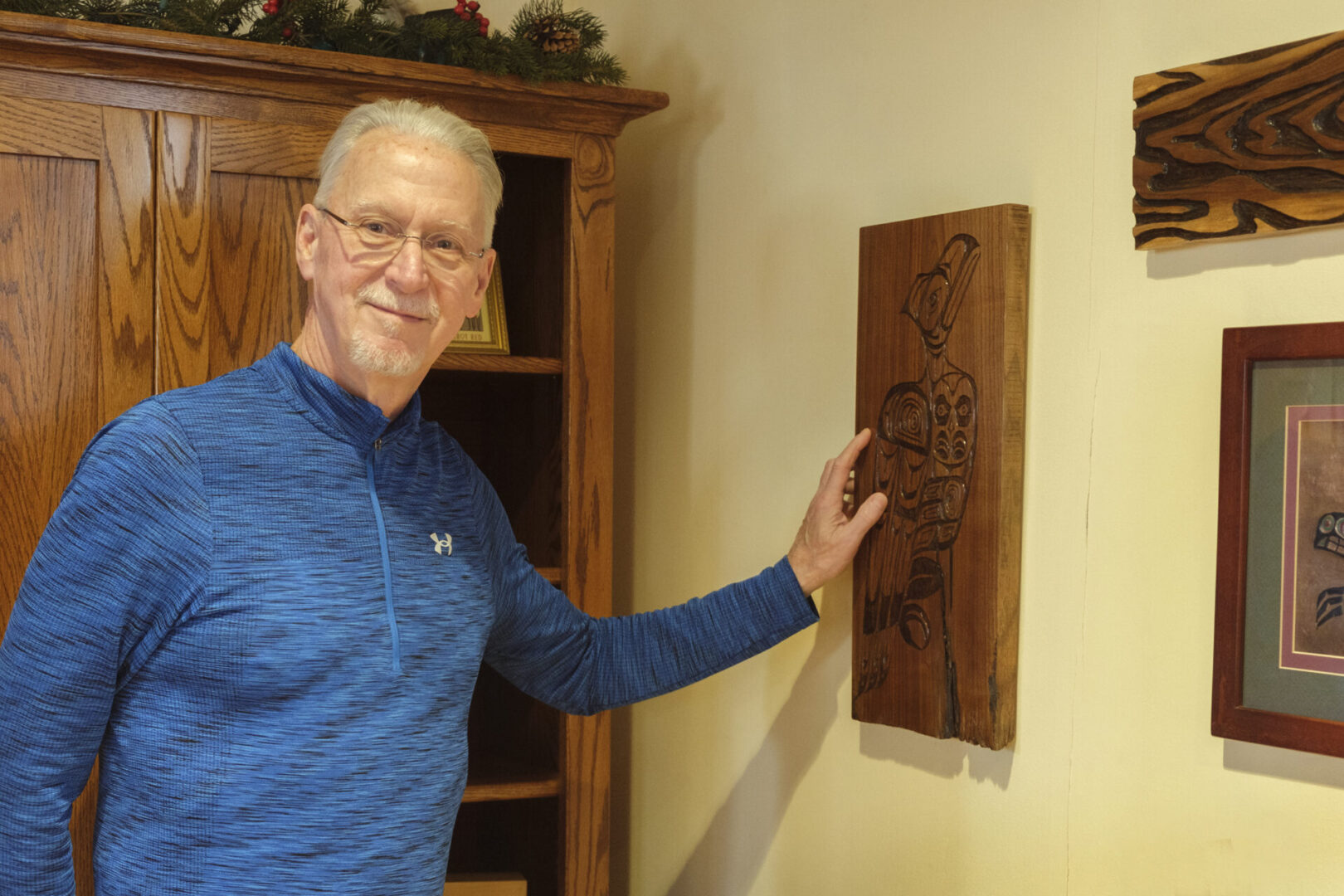Artist Jim Jackson takes his creative inspiration from nature and other cultures, especially the indigenous people of the Pacific Northwest.
A native of Wellsboro, Jackson taught elementary art at Blackhawk School District near Pittsburgh for fourteen years before moving to Bellefonte and marrying his wife, Peggy, a math teacher. He retired after seventeen years of teaching art in the Bald Eagle Area School District and is an active member of the Bellefonte Art Museum’s Artist Registry and a former docent.
The walls of his arts-and-crafts-style home in Bellefonte display a variety of art works created by Jackson and other artists he admires, and unknown craftspeople from traditional cultures around the globe. “I buy art to support others,” he says.
His own work includes watercolors and bas-relief sculptures made of copper and of wood. He describes himself as a jack of all trades. “I don’t think anyone ever really masters anything.”
For the works on copper metal sheets, he creates slightly raised designs inspired by the indigenous art of the Pacific Northwest. He adds colorful acrylic paint to the raised images and then seals his work with a water-based varnish to keep the copper bright.
Regarding his watercolors, he says, “I like watercolor because you can do a sky really fast. Just blend your colors that you think you see in the sky and go on from there. My watercolors are a little different than other people’s. Mine almost look like acrylic, the way I work the watercolor.”
Jackson’s current focus is on black walnut relief carvings, especially leafless trees. “I try to do things that are different than what everyone else does, even when working with copper or wood, which are common materials.
“I tried to use a piece of oak. Oak is a really stringy wood. Cherry and mahogany are softer woods and they tend to split more when I’m working with them. So, I honed in on black walnut.

“Carving walnut is not like carving basswood, which is a preferred wood of wood carvers. Because [basswood is] a soft wood, the grain doesn’t get in your way. You can carve in any direction. That’s not the case with walnut. It’s a real struggle going against the grain at times,” he says.
For his first black walnut relief carving, Jackson tried to carve away the background and leave the image of the tree as the highest part. Small branches broke off during carving. At the suggestion of his wife, he now carves into the wood to create the shape of the tree, which prevents breakage and preserves more of the wood’s grain.
To hold the wood in place on his workbench, he places it on a folded towel, which he rotates to change directions as he carves. He uses a set of twelve Pfeil Swiss-made gouges to make different size lines, and taps them with a woodworker’s plastic mallet to carve out the wood.
“I have a plan going in and a drawing. If I need to make a change, I make a change,” he says. “I just get into a zone with it and carve away. It’s so relaxing. I look up and four hours have gone by and I don’t even know I’ve been doing it that long.”
He hand-stains every carved line on his wooden pieces with Minwax Ebony and Jacobean stains using a very fine brush. “Only the carved lines are stained and everything else is varnished with polyurethane.”

A large relief carving of an oak tree he recently completed for a commission was twenty-six inches high by thirty-nine inches wide. He completed it in three pieces, as a triptych, joining the sections with metal cletes. He has also used oak to join other triptychs, or kept the sections separate.
A small piece averages thirty to sixty hours of work. The large oak triptych took 125 hours.
Jackson says he became interested in art because of the encouragement of his elementary school art teacher, Miss Mason. He had her identical twin sister, also Miss Mason, for middle school art, and his elementary teacher again for senior high art class.
“I had Miss Mason for all twelve years of art,” he jokes. “She was a great teacher.”
Jackson majored in art education at Edinboro State University and obtained a master’s degree in art from the University of Pittsburgh, going on to encourage his own students.
One student was struggling in art because he was colorblind. Jackson asked him if he was interested in cartoons and taught him about blocking, arrangement on the page, and more. The student thrived, and Jackson later learned that he went on to a high-paying career illustrating X-Man and other Marvel comic books.
When asked what he wants people to get from his work, Jackson says, “Peace and tranquility. A sense of calm. Just looking at it and finding new things to see. Appreciating something they haven’t seen before.” T&G
Karen Dabney is a freelance writer in State College.




